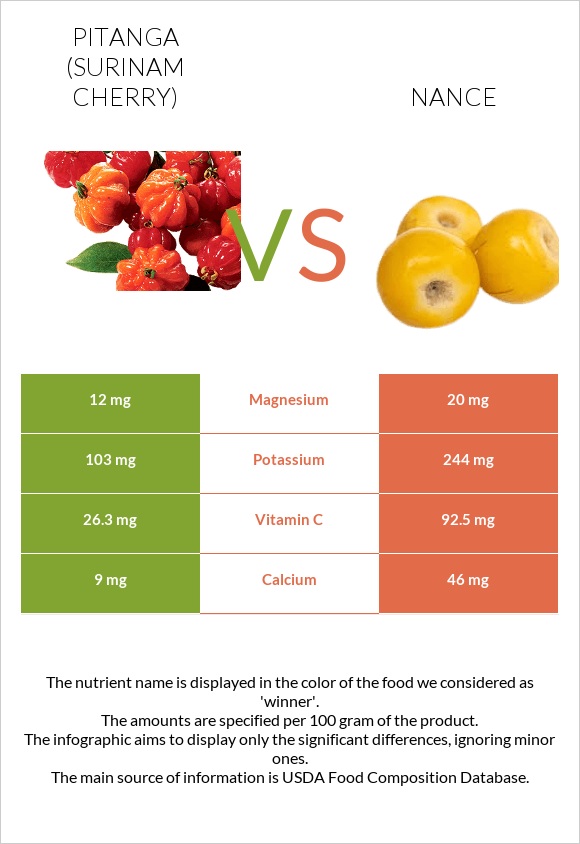Pitanga (Surinam cherry) vs. Nance fruit — In-Depth Nutrition Comparison
Compare
A recap on the differences between pitanga (Surinam cherry) and nance fruit
- Pitanga (Surinam cherry) is higher in vitamin A, yet nance fruit is higher in vitamin C.
- Nance fruit covers your daily vitamin C needs 74% more than pitanga (Surinam cherry).
- Pitanga (Surinam cherry) contains 20 times more vitamin A than nance fruit. While pitanga (Surinam cherry) contains 1500 IU of vitamin A, nance fruit contains only 74 IU.
Food varieties used in this article are Pitanga, (surinam-cherry), raw and Nance, frozen, unsweetened.
Infographic

Infographic link
Mineral Comparison
Mineral comparison score is based on the number of minerals by which one or the other food is richer. The "coverage" charts below show how much of the daily needs can be covered by 300 grams of the food.
| Contains more MagnesiumMagnesium | +66.7% |
| Contains more CalciumCalcium | +411.1% |
| Contains more PotassiumPotassium | +136.9% |
| Contains more IronIron | +90% |
Vitamin Comparison
Vitamin comparison score is based on the number of vitamins by which one or the other food is richer. The "coverage" charts below show how much of the daily needs can be covered by 300 grams of the food.
| Contains more Vitamin AVitamin A | +1775% |
| Contains more Vitamin B1Vitamin B1 | +100% |
| Contains more Vitamin B2Vitamin B2 | +122.2% |
| Contains more Vitamin CVitamin C | +251.7% |
All nutrients comparison - raw data values
| Nutrient |  |
 |
DV% diff. |
| Vitamin C | 26.3mg | 92.5mg | 74% |
| Fiber | 7.5g | 30% | |
| Manganese | 0.248mg | 11% | |
| Vitamin K | 11.9µg | 10% | |
| Vitamin A | 75µg | 4µg | 8% |
| Vitamin E | 1.25mg | 8% | |
| Fructose | 4.73g | 6% | |
| Copper | 0.041mg | 5% | |
| Calcium | 9mg | 46mg | 4% |
| Potassium | 103mg | 244mg | 4% |
| Vitamin B5 | 0.18mg | 4% | |
| Carbs | 7.49g | 16.97g | 3% |
| Calories | 33kcal | 73kcal | 2% |
| Magnesium | 12mg | 20mg | 2% |
| Iron | 0.2mg | 0.38mg | 2% |
| Vitamin B2 | 0.04mg | 0.018mg | 2% |
| Vitamin B6 | 0.021mg | 2% | |
| Folate | 8µg | 2% | |
| Fats | 0.4g | 1.16g | 1% |
| Zinc | 0.09mg | 1% | |
| Selenium | 0.4µg | 1% | |
| Vitamin B1 | 0.03mg | 0.015mg | 1% |
| Protein | 0.8g | 0.66g | 0% |
| Net carbs | 7.49g | 9.47g | N/A |
| Sugar | 8.31g | N/A | |
| Phosphorus | 11mg | 10mg | 0% |
| Sodium | 3mg | 3mg | 0% |
| Vitamin B3 | 0.3mg | 0.29mg | 0% |
Macronutrient Comparison
Macronutrient breakdown side-by-side comparison
Protein:
0.8 g
Fats:
0.4 g
Carbs:
7.49 g
Water:
90.81 g
Other:
0.5 g
Protein:
0.66 g
Fats:
1.16 g
Carbs:
16.97 g
Water:
80.64 g
Other:
0.57 g
| Contains more ProteinProtein | +21.2% |
| Contains more WaterWater | +12.6% |
| Contains more FatsFats | +190% |
| Contains more CarbsCarbs | +126.6% |
| Contains more OtherOther | +14% |





